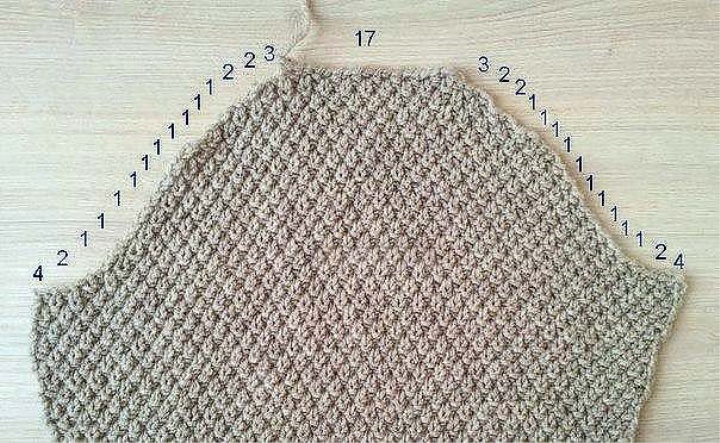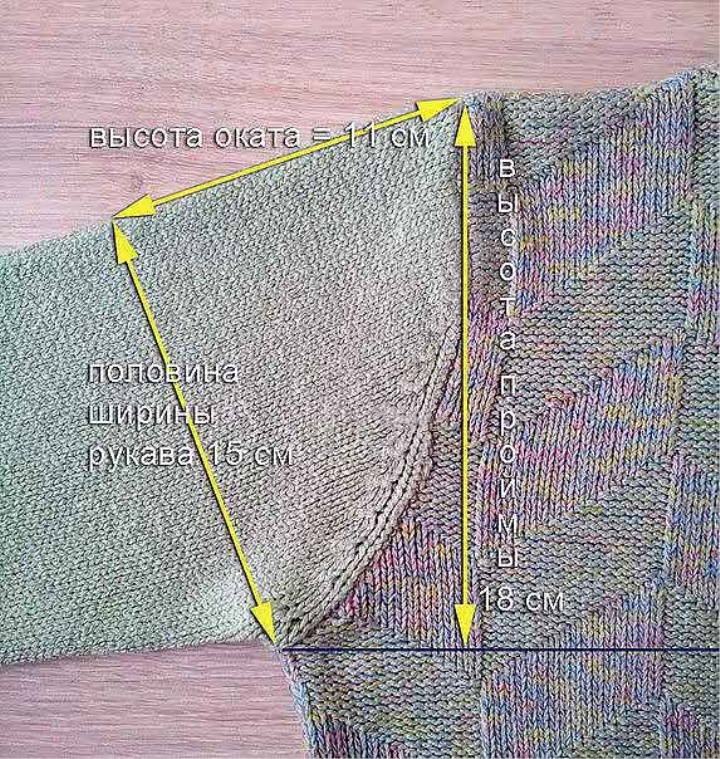
Step 4. Proceed directly to the calculations for knitting sleeve sleeves:
-Measure the width of the sleeve = 30 cm and translate directly into the loops 3 x 21p. = 63 loops;
-Measure the height of the Okata = 11 cm or 1.1 x 29 = 32 Series, for this number of rows it is necessary to tie the whole sleeve of the sleeves;
-Another required value is the width of the straight line at the top of the okata. I put the sleeve so that the shoulder line is centered and measure the desired value-11.5 cm. If I refer to the theory of the okata construction, I have seen a recommendation to make the line width at the top of the Okata = 5-6 cm. Perhaps this is a classic sleeve of the sleeves, but I have to such a soul does not lie, as do not like the measured value in the finished blouse, so I will allow it to reduce and make = 9 cm, that in the recomputation of loops = 19 loops.
All the necessary measurements are made, it remains to distribute the closure of the loops to form the okata of the sleeve.
I will present the received information for the correct presentation together:
-Before the start of knitting the sleeves on the spokes are 63 loops;
-The Okat must be completed in 32 series;
-width of a straight line on the top of the Okata 19 loops.
Let me remind you that any closure of loops is classically done by every 2nd row.
Not being distracted by the theory of calculating the width of the armhole (although there is nothing complicated, to create a smooth line of armholes closing loops make from a greater number of loops to less for several calls), I will write, what closure loops Armi had: 4, 2, 1, 1. Why do you need these values? The same closing loops should be made and at the beginning of knitting okata sleeves, i.e. to close every 2nd row on both sides of a loop cloth in the order of 4, 2, 1, 1.
Total of 8 rows, closed (4 + 2 + 1 + 1) х2 = 16 loops and on the spokes left 63-16 = 47 loops.
Immediately exclude from the calculations loops of the top of the Okata: 47-19 = 28 loops still need to close on both sides of the sleeve, respectively, on the one hand to close 28/2 = 14 loops for 22 rows = 32 R. (total number)-8r (already proyazthe)-2r (to close the central 19 loops).
For a smooth rounded okata on top of the penultimate closing loops will do, for example, such: 2, 3, 4. This will take 6 rows and 9 loops on each side.
It remains to close the average 14-9 = 5 loops of Okata for 22-6 = 16 rows. Closing one loop each 2nd row, will need 10 rows. 6 rows Extra. Removing rows means reducing the altitude of the okata, which is wrong. The second solution-a little change the line of the Okata, in the finished product it will be almost unnoticed, so I make an adjustment of the folding loops. For 6 rows you need to get 6 loops, 3 loops on each side of the okata.
Let the width of the top of the okata will not be 19, and 17 loops, it will give 2 unused loops, plus adjust the penultimate closing loops for bevel okata and instead of such a sequence of 2, 3, 4 do so 2, 2, 3, which frees up another 2 loops with Each side. Total 6 necessary loops found and the final layout of closing loops for the sleeve will look like this:

4, 2, 1, 1, 1, 1, 1, 1, 1, 1, 1, 1, 2, 2, 3, 17, 3, 2, 2, 1, 1, 1, 1, 1, 1, 1, 1, 1, 1, 2, 4.
This layout can be seen in the photo (the sample has a different layout of loops and is presented for a visual example, so do not try to at loops to find a match made calculations smile).